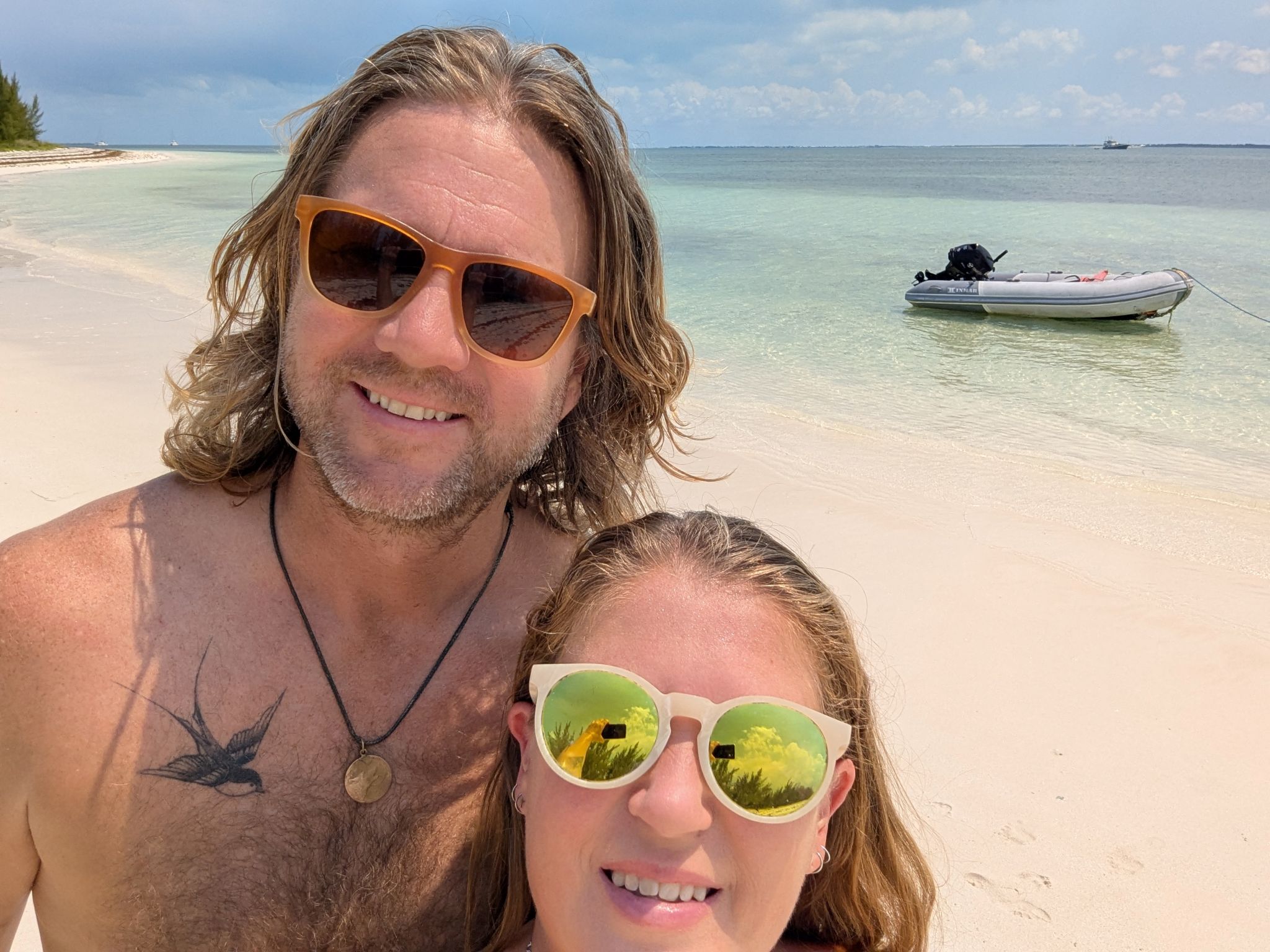Like all good things, they must at some point, come to an end. After almost 90 days in The Bahamas, we were looking for a weather window to head back to the states. While I was checking the extended forecasts for the Abacos, favorite port of calls all along the east coast, and the ocean conditions in between, we started prepping ourselves and the boat for our eventual departure back to the states.
Our last stop was at Green Turtle Cay. Due to wild and shifting winds, we spent our last week shuffling between the Green Turtle Club and the Bluff House Marina because of availability at the marinas. We took that time to take advantage of fueling up the boat , fill up with water, provision at the grocery stores, and doing all the engine checks prior to our departure. We also spent the time going to our favorite haunts. We had breakfast at the liquor store and at the Green Turtle Club (they have 2-for-1 mimosas so be careful how you order them). We also had to have pizza at Sundowners with Ronel and Kelia, the wonderful owners.





We also spent time wandering the beach looking for shells and just trying to soak up all the beauty that we can. We took the time to “relax” with some mean games of chess, which has turned out to be one of our favorite ways to pass the time in the sand.





After about a week, the weather finally settled down and we were able to come back out and anchor in the bay for a few nights. Moving away from a marina puts us back into more of a cruising mode and allows us to put up/stow away all of our dock lines, power cables and gives us more freedom to move when the weather changes. We were hopeful for an upcoming weather window so we mounted the dinghy motor on the stern railing and deflated Lady to stow her safely on the bow. Once the dinghy was on the boat, we were committed to leaving.




We had plans to get back to the US and to quickly make our way up to Baltimore. We have an annual slip reserved there and are looking forward to getting back up to the Chesapeake. With that in mind, I started looking for a weather window to get us as far north as we can which would have us taking advantage of the Gulf Stream. This would give us an extra 2-4 knots of speed up the coast. The only downside is that we have to go west to reach the stream and its a good distance offshore which would mean that we would have to be very self sufficient during our passage. Last year, we jumped into the Gulf Stream but exited quickly to make it to St. Augustine. That trip was 250nm and just at 2 days of travel. In plugging in a possible route into PredictWind for a passage to Charleston, SC, it would take about 3 days. I found it fascinating that it would only add about 6 hours to make it to Southport, NC and only a few more hours to make it all the way to Beaufort, NC. This is only possible if we take full advantage of the Gulf Stream. So, somehow after more than a week of multiple cold fronts coming through giving us winds from the north, I found a weather window with winds moving from the east to the south, decreasing waves, and sailable wind for 4+ days. Unfortunately, this meant that it was time for us to leave one of our favorite spots, Green Turtle Cay. We sailed up the Great Sale Cay to stage for our offshore passage.




I checked and double checked, had Justin check and then I triple checked (you get the point) the weather forecasts and routing for our passage options. We determined that we were good to go all the way to Beaufort, NC. It was predicted to to take 3-3.5 days and over 550nm. The waves were going to start off a bit larger than we typically want (6 feet or 2 meters) but they were expected to continually decrease and be more comfortable as the trip progresses. This will be our longest and furthest offshore passage of our sailing career (we hugged the coast from Galveston to Mobile, AL for 464 nm and 79 hours). We had our ditch bags packed, life jackets out and jack lines prepped. We let our group chat know our route and possible bail-out points if things went sideways. We also switched our Starlink to “priority” mode so that we would have internet the entire time for up to date weather and routing info and to stay in touch with our group chat for updates and wellness checks along the way.




It is always sad to leave the people and the culture/history of The Bahamas, it is also fascinating to watch the color of the water go from beautiful turquoise green while on the shallow Bahamas Shelf to a dark blue once the water deepens and our depth finder can no longer register a number. Once we were out of the protection of the islands, the waves picked up to be about 6 feet and would push us along from behind. We had a 1-2 knot current with us as we sailed NW to find the Gulf Stream and we knew pretty quickly when we were in it as the current jumped to a consistent 3-3.5 knots. We even saw 4-5 knots at one point. We also were greeted by a pair of dolphins which played on our bow as we moved through the water which was a good omen for the passage.





Knowing that we had at least 3 days on the water, we tried to quickly get into a watch schedule. Luckily our autopilot acts as a reliable 3rd crew member who is always manning the helm and keeping us on the course we set. Justin is very good at putting our route in the chart plotter and keeping it updated with the current info every 12 or so hours and making sure that the engine and batteries are working properly. I’m good at making sure that we have on our safety gear and proper clothing for the elements as well as making sure that we’re properly fed and hydrated. We’re both in charge of managing our course and speed with the sails and/or motor, avoiding stuff on the radar/AIS, and making sure that the autopilot is doing what it’s supposed to. Justin, unfortunately, was always on call to help me with getting the headsail in or out due to it being cumbersome and finicky at times. The watch schedule that works for us is to either be in the cockpit in charge of the boat or trying to rest/not pay attention, in the cockpit or in the cabin, and switching roles every 4 hours. During the daytime and since we had internet, we played on our phones and I tried to finish my latest book series. At night, to preserve our night vision, we listened to a lot of podcasts.




There were times of epic sailing with too much wind causing us to reef, reduce the sail area, of both our mainsail and our headsail. We also had times when the wind either died or was coming from directly behind us making us have to turn on the motor to maintain a good speed. We were concerned about having enough fuel for the whole journey so we were conservative in the beginning and didn’t run the engine at all or just kept it at low RPMs to keep our fuel consumption low. We have a 40 gallon tank with 15 gallons in jerry cans which gives us a conservative estimate of about 70 hours of motoring at full speed. We use about .8 gallons at our typical running speed at 3000 RPMs which is reduced to about .5 at 2800 RPMs. Once we got to about a 1/2 tank, Justin waited until the waves had died down a bit to use the jerry cans to get the gage back to full and get a good reading of our fuel usage. We were about half way through the trip at that point and were super excited to know that we would have fuel to make it the rest of the way at our running speed, if we needed it.




We went through multiple sunsets and sun rises and multiple watch changes which included a quick debriefing on what we saw, what the weather’s doing, if we’re still on course and strategies on how to get back on course or if something is showing up on the radar/AIS that needs to be watched. We basically just high-fived each other as we left the helm to go and get some rest. To bookend the trip, we were met by another set of dolphins as we finally saw land for the 1st time in 3 days.





Our passage took us 57 nm in 10 hours from Green Turtle Cay up to Great Sale Cay to get a restless nights sleep before heading offshore. Then we made it from Great Sale Cay in the Abacos of The Bahamas to Town Creek Marina in Beaufort, NC in 78 hours, 40 minutes and 560 nautical miles (644.5 statute miles). We kept an average of 7.1 knots (8.1 MPH) and a max speed of 11.2 knots (12.9 MPH) due to the lovely Gulf Stream and following waves. Like this whole sailboat cruising thing, this was a trip of a lifetime. It was as daunting as it was exhilarating.



We’ve shaved so much time off of our trip north by making landfall in Beaufort, NC. If we didn’t have to stop for weather or sanity, we could be back in Baltimore in only 5-6 more days. Realistically, it will take us a couple of weeks of travel and recovery time to make it back to the upper Chesapeake but boy do we have a nice head start.
“Sailing is basically hours and hours of boredom interjected with a few moments of sheer terror.”- Unknown






Justin and Shannon,
Thanks for sharing the back story behind this epic journey, the thinking that goes into it, the planning and checking, the attention to detail, and the insight into your feelings as you prepare to leave. There is always a degree of sadness at leaving and a degree of apprehension when embarking on a trip – especially one in which you have total control of the route and of keeping yourselves safe in the process. Those of us unfamiliar with your lifestyle may dismiss such a trip with blithe disregard, thinking of your trip as akin to driving their car – but it’s so very different! Years ago I flew light aircraft, and I can guarantee I spent as much time planning as any of the flights I undertook. Such skilled execution comes from an attitude of respect for the elements, constant vigilance, with safety being front of mind. Thanks for the insight into the care and artistry you bring to your endeavours.
Russell, thank you for reading! We’ve done quite a lot of 24hr trips and a few of 48+ hours but this one felt exponentially bigger. We felt it and I know that everyone in our “flight plan” chat group felt it. A lot of things could have gone haywire but we’re so thankful that it didn’t. One can only be as prepared as possible for whatever may come. Cheers! – Shannon